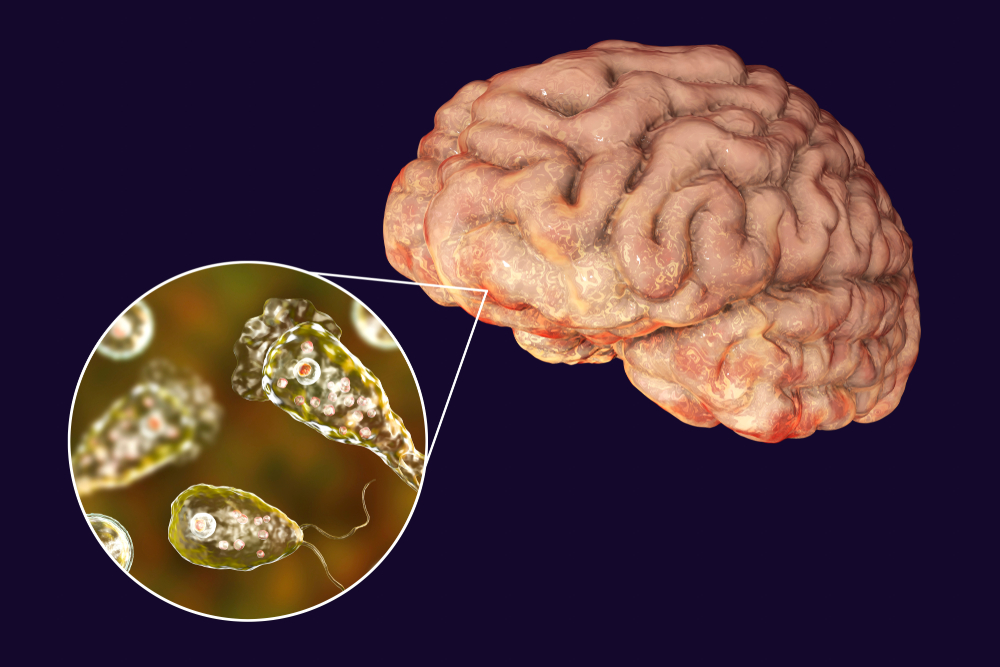Naegleria fowleri: The Brain-Eating Amoeba
Posted on Categories Discover Magazine

A creature that lurks in lakes and ponds, crawls up your nose and eats your brain. Sounds like something out of science fiction, right? Nope, it’s all too real.
The organism that does all this damage is called Naegleria fowleri. Find out why this sneaky predator is alarming to both scientists and the general public.
What Is Naegleria fowleri?
Naegleria fowleri is a microscopic amoeba that lives in warm freshwater, such as lakes, ponds and rivers. There are many species of Naegleria, and most of them do little or no harm to humans.
They eat bacteria and other detritus, explains Dennis Kyle, professor of infectious diseases and director of the Center for Tropical and Emerging Global Diseases at the University of Georgia.
But one of these amoebas, Naegleria fowleri, can infect humans, says Kyle, one of the world’s top experts in pathogenic free-living amoebas. Naegleria fowleri enters your body through the nose, crosses the epithelial lining and then makes a beeline up the olfactory nerve to the frontal part of the brain.
There, it does to your brain tissue what it would otherwise be doing to all that lake detritus: It dissolves the proteins and liquefies the adjacent area as it advances (and multiplies) in your brain. If the name “brain-eating amoeba” seems a little sensationalist, this situation is pretty sensational. It might even be more accurate to call it a “brain-liquefying amoeba.”
Read More: What If We Tolerated Diseases?
What Are The Symptoms of Naegleria fowleri Infection?
The amoeba lives in warm freshwater around the world. In the U.S., it’s typically found in southern states, though according to the Centers for Disease Control (CDC), it has been found in northern states like Minnesota.
Most people contracted the disease from snorting lake or river water up their noses. However, in some cases, officials have traced it to improperly chlorinated water in pools or water parks. Using a neti pot poses a risk as well. The CDC recommends using boiled or distilled water if you rinse your sinuses for health or religious purposes. Municipal water treatment is not enough to kill Naegleria fowleri, says George Rust, physician and director of the Center for Medicine and Public Health at Florida State University. But don’t worry, you can’t get infected from drinking tap water or taking a shower, he says.
Symptoms usually begin about five days after exposure. These include headache, fever, nausea and vomiting. Soon, this progresses to stiff neck, confusion, seizures, hallucinations and coma. The disease is called primary amoebic meningoencephalitis (PAM).
Read More: Antibiotic-Resistant Bacteria: What They Are and How Scientists Are Combating Them
The Risks of Getting a Brain-Eating Amoeba
Okay. This is scary. Fortunately, infection with Naegleria fowleri is exceedingly rare. According to the CDC, only 157 cases were identified in the U.S. between 1962 and 2022. That’s fewer than three a year. Compare that with, say, automobile accidents. According to the National Highway Traffic Safety Administration, more than 40,000 people in the U.S. die in automobile crashes yearly.
So, the risk of having your brain dissolved by a rogue amoeba is very low. That’s the good news. The bad news is that infection with Naegleria fowleri is almost always fatal. Of the 157 people infected in the U.S. in the last 60 years, only four survived.
Read More: The Dangers of Sepsis and How to Treat It
How Is Infection with Naegleria fowleri Treated?
Treatment is difficult for a couple of reasons. Because it’s so rare, few physicians have ever seen PAM. Also, the infection progresses very quickly; death can occur within five days of the onset of symptoms. Kyle adds that the symptoms are identical to bacterial or viral meningitis symptoms. He says most physicians will look for these infectious agents, not brain-eating amoebas. This means it’s often too late before they even think about PAM.
Even when doctors know what they’re dealing with, there still aren’t a lot of treatment options. “The treatments,” says Kyle, “are really not optimal. They’re things off the shelf that are used for bacteria or fungi.” However, some drugs are thought to be at least somewhat effective. In the laboratory, Miltefosine, An experimental drug, has been shown to kill Naegleria fowleri and was used on some of those who survived.
One lucky survivor was treated with Miltefosine in combination with hypothermia. This treatment lowers the patient’s body temperature to around 93 degrees Fahrenheit. “The lower body temperature helps reduce the swelling and inflammation,” Kyle says. This gives the Miltefosine a chance to work. “I think your body’s immune response, not just what the amoeba is doing to the brain, is really what causes a lot of the pathology,” he says. It also helped that the victim in this case got early treatment and the cause was identified quickly.
Read More: What Is Inflammation, and Why Is It Sometimes ‘Bad’ for Your Health?
Are Naegleria fowleri Infections Becoming More Common?
Infection with Naegleria fowleri may be becoming more common — or at least it may be spreading. Because the amoebas live in warm water, U.S. cases have typically occurred in southern states, such as Florida, Georgia and Texas. But that may be changing.
Since 2010, cases have been confirmed in Nebraska, Iowa, Minnesota, Indiana, Maryland and northern California, according to the CDC. This could be due to climate change, says the agency. As air temperatures rise, so does water temperature, providing more happy homes for this deadly amoeba. Heat waves, which we are seeing more of, can also increase water temperatures, providing more places for Naegleria fowleri to thrive. “I think,” says Rust, “the ecosystems are trying to tell us that global warming is real.”
Read More: Climate Change is Likely to Increase the Risk of Infectious Diseases